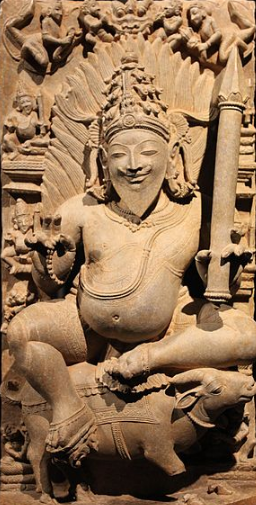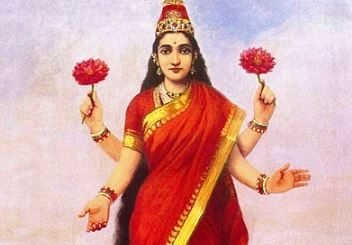Agni: God of Fire and Sacrifices in Hindu Mythology

Agni – myths and facts | Agni – the divine personification of the fire used during sacrifices in Hinduism
Agni is the god of fire in Hinduism. As a matter of fact his name literally translates into the word “fire” in Sanskrit. Born to the creator god Brahma, Agni is revered as the deva (god) who accepts worshipers’ sacrifices.
He is also the god of divine knowledge and wisdom, making him a very important deva among Hindus. In terms of importance, Agni often comes in second, after Indra, king of the Devas, according to the Vedas.
Family
- Father: Brahma
- Wives: Swaha, Sudarshana
- Sons: Skanda (Karttjkeya), Pavak, Shuchi and Pavanmaan
Birth Story
There are quite a number of stories surrounding Agni’s birth. The commonly held one is that he was born to Lord Brahma, the creator god in Hindu mythology. There have been some accounts that say that he was instead born to the sage Kashyapa and Aditi.
Some say he was born to ten mothers, who were all sisters. Those who hold this belief use this story to explain the origin of our ten fingers.
Agni’s sisters are said to be the embodiment of night and dawn. For his consort, Agni married the Hindu goddess Swaha (Svaha).
Agni and the goddess Swaha
After going through a great Rajasuya Yagna, an Imperial Sacrifice in the Vedic religion, Agni fell head over heels for wives of the Saptarishis (Seven Sages) who had also come to perform the yagna. Knowing quite well that there was absolutely no chance that any of those seven women would leave their husbands, Agni walked off his frustration in the forest.
Sensing the hopelessness in Agni, Swaha, one of the daughters of the great guru Daksha, turned herself into the wife of Agiras. Swaha hoped to use that disguise to win Agni’s heart, for she had desired to get married to Agni for a very long time.
Swaha’s disguise worked and she was able to win the Lord of Fire’s heart. Ultimately, Agni saw through Swaha’s disguises. Rather than send her away, Agni went ahead to marry Swaha.
By Swaha, Agni is the father of the Hindu god of war Skanda (also known as Kartikeya or Murugan). In some other accounts, however, Skanda is the son of Parvati and Shiva.
Importance of Agni’s wife Swaha
The bond between Agni and Swaha was so strong that he commanded his worshipers to always include Swaha’s name whenever offering sacrifices or offerings to him. Hindus believe this explains why Swaha’s name is uttered every time an offering is poured into the ritual fire.
Agni’s wife Swaha (or Svaha) also represents Agni’s Shakti, which is the cosmic energy that flows through a deva.
The Three Sons of Lord Agni
In the Vayu Purana, Lord Agni is said to have three sons that represent his three major forms. The first son Pavaka stands for Agni’s electric fire. The second son Pavamana represents the heat that emerges from friction. Finally, the third son Suchi represents Agni’s fire emitted from the Sun.
Association
Typical of many Hindu gods, Agni is often identified with a number of Hindu gods, both minor and major gods. Notable associations include Soma (Chandra), Savitr (the Sun), Rudra (Shiva), Mitra, and Varuna.
Depiction and symbols
Agni deva is usually depicted with the symbol of the ram. The ram is symbolic of his association with sacrifices.
Lord Agni is often seen with two faces; one head/face represents immortality, while the other represents life. It’s also believed that the two faces of Agni represented his two contradictory sides of benevolence and malevolence.
His hair is believed to light up like burning flames. He has either three or seven tongues. His legs are three in number, while he has seven arms.
Role and Importance

Agni – the fire-god in Hindu religion and mythology is a very important deity. In the Vedic mythology, Agni is second only to Indra, the king of the gods. | Image: symbol wood carving ram in Guimet Museum
In addition to being in charge of both domestic and sacrificial hearth, Agni is believed to be the one who fuels the sun. He also causes the occurrence of lightning. Some ancient texts in Hinduism state that Agni resides in three levels – on earth, he seen as fire; in the air, he appears as lightening; and in the sky, he reveals himself as the sun.
In Hinduism, it is believed that Agni is responsible for burning the food in everyone’s stomach.
As a deity of the hearth, Agni serves as the mouthpiece of the gods in Hindu religion. He acts as the intermediary between the divine devas and humans.
During tradition weddings (i.e. Agnipradakshinam or Saptapadi) or cremation ceremonies, Agni is invoked to bear witness to the ceremony.
The Five Elements in the Universe

Agni with an aura of flames, seated on ram.
Agni’s importance lies in the belief that he works as the link between the heaven and earth, and humans and gods.
As the personification of fire, Agni is part of the five elements in the universe, which includes earth (pṛthvī),space (ākāśa), water (ap), and air (vāyu). All five elements come together to form Prakriti, which is described as the material existence that we perceive.
Agni serves as the conduit through which sacrifices and offerings reach the gods. He, thus, receives the sacrifices during Homa, a fire ritual performed by a Hindu priest as some sort of housewarming present. A number of fires kept by the homeowner – fire for cooking, fire for heating, and among others.
Agni and the wise sage Angiras
In one of the myths, a very wise sage named Angiras attained immense intellect and powers after going through a very arduous penance. Angiras’s immense brilliance was said to even rival that of Agni’s. This resulted in many worshipers offering prayers to Angiras instead of Agni.
Feeling very rejected, Agni headed into the forest to drown his sorrows. However, it turned out that Agni’s absence caused a lot of misery and unhappiness in the world.
As a result, Angiras ventured into the forest to console Agni. Angiras sent Agni to the creator god Brahma who ruled that Angiras be seen as the son of Agni. Going forward, Agni regained his appeal among the people.
The Agni Purana
The Agni Purana are said to be the writings of Ved Vyas who had received the knowledge of the Brahmana from Vashistha, one of the saptarishis. Vashistha, in turn, received that knowledge from Lord Agni.
Agni’s obsession with Sudarshana, the daughter of King Nila
The fire deity Agni once fell completely in love with Sudarshana, the extremely beautiful daughter of King Nila of Mashishmati. His unchecked infatuation with Sudarshana resulted in him marrying her.
Deva Agni and Svetaki
In one of the myths, Agni experienced an indigestion problem after he was overfed with lots of food and sacrifices by Durvasa rishi during King Svetaki’s 12-year yagna. It’s been said that Agni got very drowsy and lost a bit of his powers for some time.
Lord Agni and the Khandava Forest
To fix his loss in form, Agni sought counsel from his father Creator god Brahma. Brahma instructed Agni to burn down the Khandava Forest. However, every time Agni tried torching the forest, the inhabitants of the forest, the Nagas, quickly put out the fire with the help of Indra’s rain. Agni then sought the wise counsel of Brahma who told him that he required the help of Nara-Narayana (Arjuna and Krishna).
Agni, disguised as Brahmin, was able to get the help of Arjuna and Krishna. Using the Gandiva bow and two fiery quivers from Varuna deva, Arjuna created a shield over the forest to prevent Indra’s rain from falling on the forest. With no rain to quench the fire that Agni had set, the forest burned down.
Following the burning of the Khandava Forest, Agni was able to regain his strength as his indigestion problem ended.
Agni and King Shibi
A wise and righteous king named Shibi once decided to embark upon a very difficult yagna so that he could be elevated to a minor deva. Wanting to test the resolve of King Shibi, Hindu deities Agni and Indra decided to put the king through a very trying situation.
Agni and Indra transformed themselves into a pigeon and hawk respectively. Agni then flew to Shibi, begging the king to keep him safe from the hawk that had been pursuing for a while. Shibi vowed to keep the pigeon safe.
Shortly after making the vow, the hawk flew in and demanded the king released the pigeon to him, saying that his starving family was counting on the pigeon meat. The king refused to hand the pigeon over, telling the hawk that he had vowed to protect the pigeon. The hawk then demanded that king sliced up a part of his thigh so that he could use it to feed his family. The king agreed to hawk’s request.
No sooner had King Shibi sacrificed a part of his thigh for the hawk than did the pigeon and the hawk turn back to Agni and Indra respectively. The gods were taken aback by the altruistic gesture of King Shibi. Agni and Indra went ahead and showered an enormous amount of blessings on Shibi.
The holy triad of Vedic gods

Agni is one of three very important gods in Vedic tradition | Image (L-R): Agni, Indra and Surya
In terms of importance, Agni often comes in second, after Indra, king of the Devas, according to the Vedas. He is the deity that gives life a certain spark. He also powers the Sun, making him of a very important deity. Agni, Indra and Surya constitute the holy triad of Vedic deities.
Agni’s three-level birth story
There is a popular belief that Lord Agni was born in three levels: earth, mid-space, and heaven. The interpretation of those levels are: the first level represents the ‘domestic fire’; the second level symbolizes the ‘defensive fire’; and the third level reflects the ‘’offering fire’ in Vedic religion.
How Lord Agni became the Divine Purifier
In one of his outburst, Agni is said to have offended a very wise sage named Bhrigu. The sage placed a curse of Agni, saying that the Lord of Fire is to become the destroyer of everything on earth. Worried about the sheer destruction that he could cause, Agni sought the counsel of Lord Brahma, who was able to change the curse. Instead of Agni destroying everything that he touched, Agni became the Divine Purifier, blessing everything that he came into contact with.
More on Agni, the lord of fire and sacrifices

Agni myths and Facts | Image: The Buddhist Fire God Katen (火天) in Japanese art. Dated 1127 CE, Kyoto National Museum.
- In the Rig Veda, there are about 200 hymns that address Lord Agni.
- As the god of the hearth, his equivalent in ancient Greek pantheon could be said to be Hestia, the Greek goddess of the hearth.
- In the Hindu text Rigveda (“The Knowledge of Verses”), the oldest-known sacred books in Hinduism, Agni is associated with Rudra, a Vedic deity and one of the names of Lord Shiva in Hinduism.
- During fire rites by Agnihotri Brahmans, Agni’s name often gets invoked.
- In some ancient Indian texts, he is seen as the guardian of the southeast. As a result, his statues and shrines are usually found in the southeast corners of the many Hindu temples.
- In many Vedic ancient texts, Agni is usually called along with Indra and Soma (also known as Chandra, the Moon deity).
- In Hinduism, it is believed that Agni is responsible for burning the food in everyone’s stomach.
- Agni has a quite a few other names, including Dhananjaya, Jivalana, and Vahni.



























